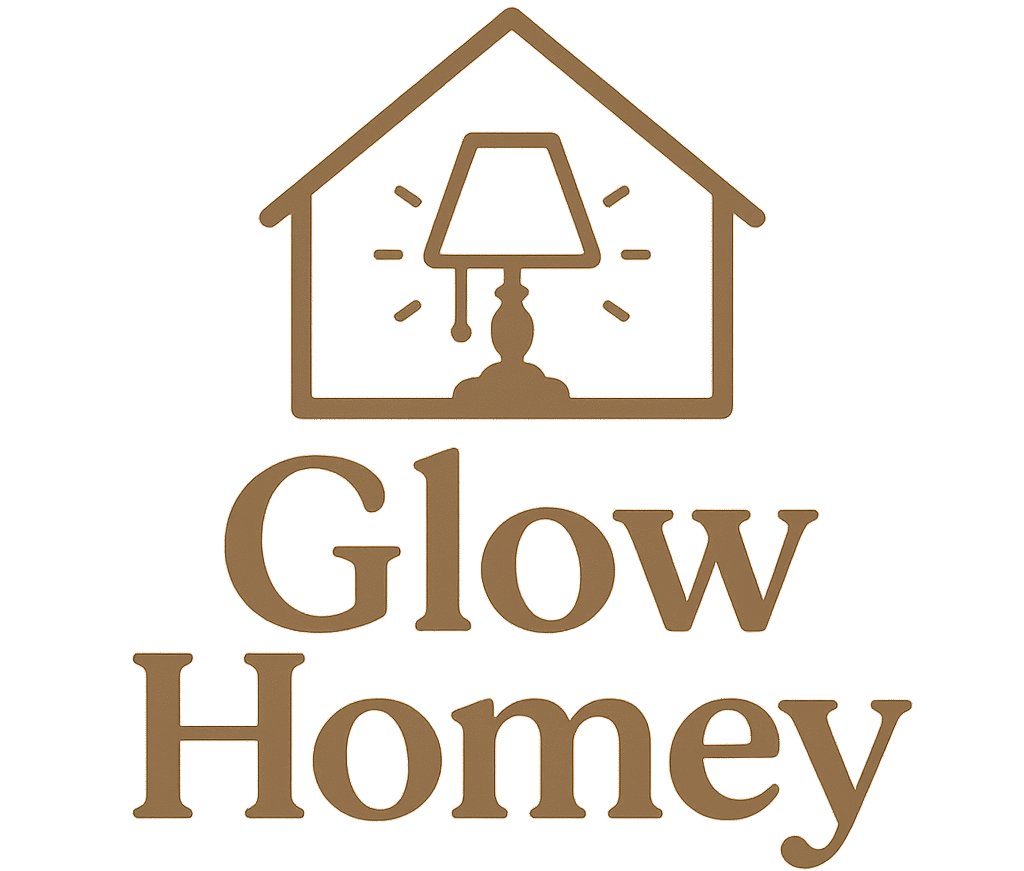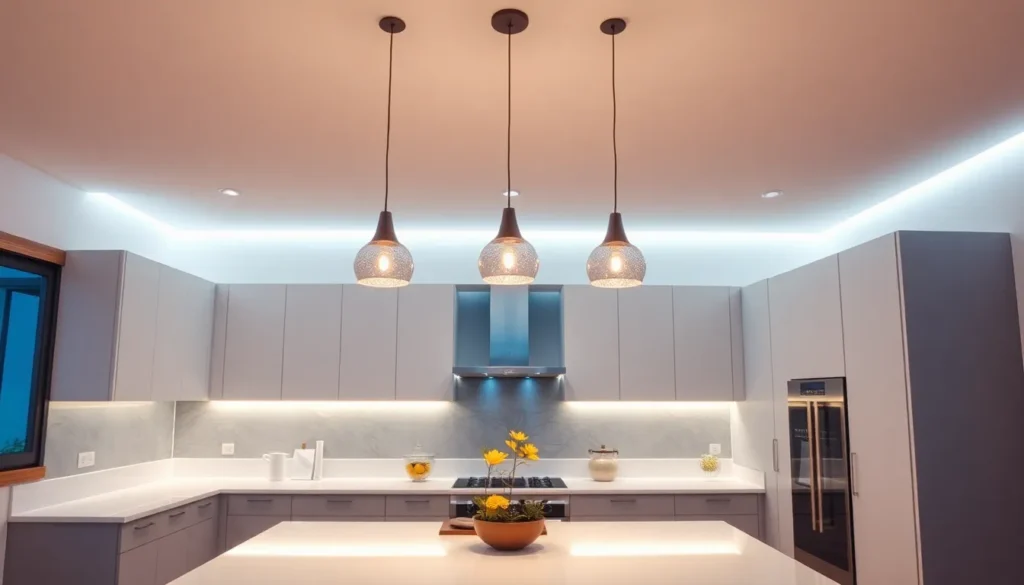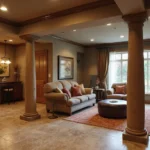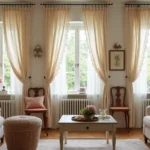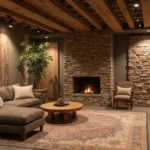We’ve all experienced that frustrating moment when we’re chopping vegetables in dim shadows or struggling to read recipes under harsh overhead lights. Kitchen lighting design can make or break your culinary experience, transforming a basic cooking space into a functional and inviting heart of your home.
The right lighting strategy doesn’t just illuminate your workspace—it creates ambiance, enhances safety, and showcases your kitchen’s best features. From task lighting that eliminates shadows on your countertops to accent lighting that highlights your beautiful backsplash, every layer serves a purpose in creating the perfect cooking environment.
We’ll explore innovative kitchen lighting ideas that blend functionality with style, helping you design a space that works as hard as you do. Whether you’re planning a complete renovation or simply updating your current setup, these proven strategies will guide you toward creating the well-lit kitchen you’ve always wanted.
Task Lighting Solutions for Your Kitchen Workspace
Task lighting targets exact work areas where you need focused illumination for food preparation and cooking activities. We’ll explore three essential task lighting answers that enhance functionality while maintaining your kitchen’s aesthetic appeal.
Under-Cabinet LED Strip Lights
Under cabinet LED strips eliminate shadows on countertops by providing direct downward illumination onto your workspace. We recommend installing these energy efficient lights along the front edge of your upper cabinets to create even coverage across your entire counter surface.
Installation benefits include:
- Shadow free cutting and chopping surfaces
- Enhanced visibility for detailed food preparation tasks
- Reduced eye strain during extended cooking sessions
- Minimal heat output compared to traditional bulbs
Color temperature options range from warm 2700K for cozy ambiance to cool 4000K for precise task work. We suggest choosing dimmable LED strips so you can adjust brightness levels throughout the day and create different moods for various kitchen activities.
Pendant Lights Over Kitchen Islands
Pendant lights over kitchen islands serve dual purposes by providing focused task lighting and creating visual interest as decorative elements. We position these fixtures 30 to 36 inches above the island surface to ensure optimal light distribution without obstructing sight lines.
Key considerations for pendant placement:
- Space multiple pendants 24 to 30 inches apart for even coverage
- Choose fixture sizes proportional to your island dimensions
- Select adjustable height options for maximum flexibility
- Coordinate pendant styles with your overall kitchen design theme
Glass pendants work well in modern kitchens while metal fixtures complement industrial or farmhouse aesthetics. We recommend installing pendant lights on separate dimmer switches so you can control brightness independently from other kitchen lighting zones.
Track Lighting for Flexible Coverage
Track lighting systems offer unmatched versatility by allowing you to direct individual light heads exactly where you need illumination. We install track systems parallel to counters or in strategic positions that accommodate your exact cooking workflow patterns.
Advantages of track lighting include:
- Adjustable light direction for changing workspace needs
- Easy repositioning of fixtures along the track
- Compatibility with various bulb types and beam angles
- Cost effective solution for irregular kitchen layouts
Modern track systems feature sleek profiles that blend seamlessly with contemporary kitchen designs. We suggest using LED track heads with narrow beam angles for precise task lighting or wider beams for general area coverage depending on your exact workspace requirements.
Ambient Lighting Ideas to Create Kitchen Atmosphere
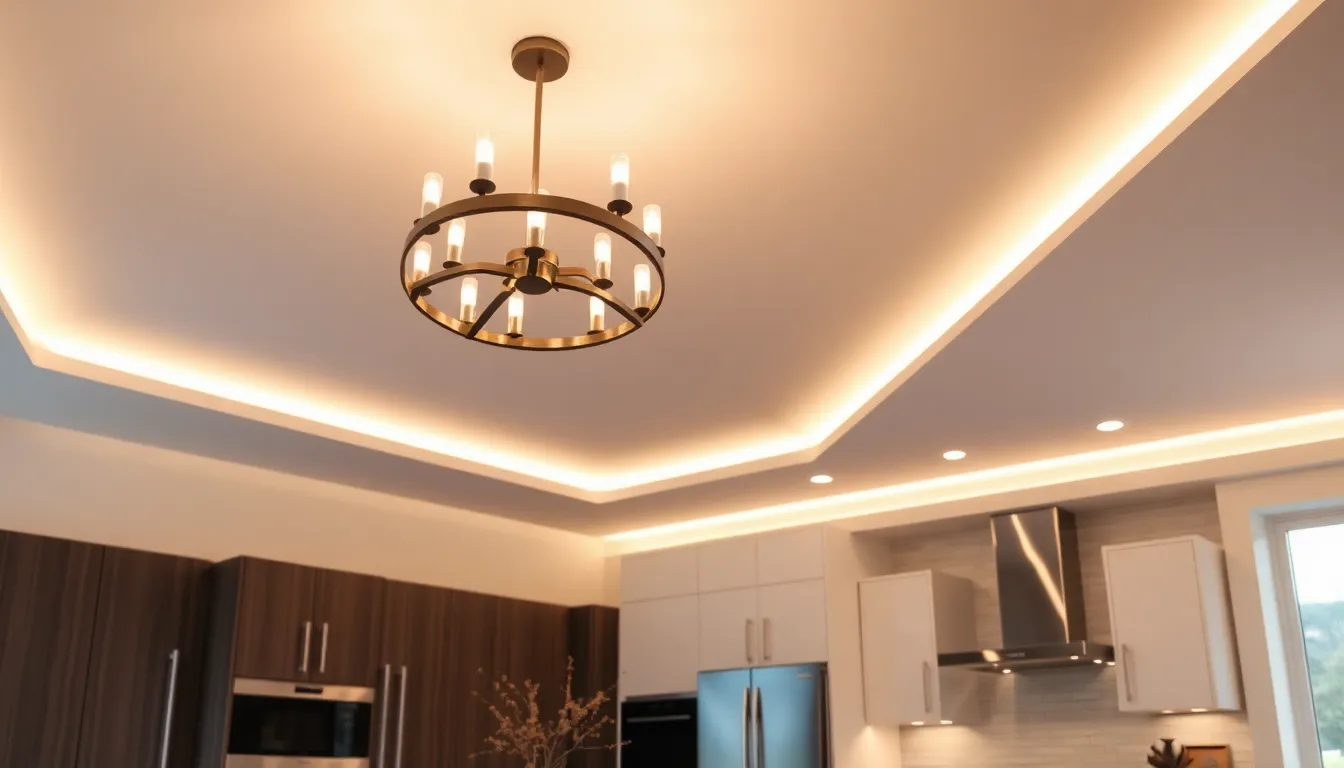
Ambient lighting creates the foundation for your kitchen’s overall mood and atmosphere. We’ll explore three essential ambient lighting answers that provide gentle, even illumination throughout your space.
Recessed Ceiling Lights for Even Distribution
Recessed ceiling lights offer the most reliable way to achieve uniform lighting across your entire kitchen. Standard recessed lights typically provide 700-1000 lumens per fixture and should be spaced 4-6 feet apart for optimal coverage. Installing them in a grid pattern ensures no dark corners remain while maintaining a clean, uncluttered ceiling appearance.
Trim recessed lights elevate your kitchen’s aesthetic with decorative elements around each fixture. White trims blend seamlessly with most ceiling colors while bronze or black trims add contrast and visual interest. Consider adjustable trim options that allow you to direct light toward exact areas like kitchen islands or dining spaces.
Dimmable recessed lights provide the flexibility to adjust brightness levels throughout the day. Morning meal prep requires bright illumination while evening dining benefits from softer, more intimate lighting levels.
Chandelier Statement Pieces
Modern chandeliers transform your kitchen into an elegant focal point while providing essential ambient lighting. Linear chandeliers work particularly well above kitchen islands, with lengths ranging from 30-36 inches for standard 7-foot islands. Crystal or glass elements reflect light beautifully, creating sparkle and visual depth throughout your space.
Traditional chandeliers bring warmth and classic charm to kitchens with vintage or farmhouse design themes. Wrought iron fixtures complement rustic elements while brass chandeliers pair beautifully with warm wood tones and earth colored cabinets.
Height placement becomes crucial for chandelier installation, with fixtures typically hanging 30-36 inches above countertops or 66-72 inches from the floor in open areas. This positioning ensures adequate clearance while maximizing light distribution.
Cove Lighting for Soft Illumination
LED cove lighting creates gentle, indirect illumination by reflecting light off your ceiling surfaces. Installing LED strips along the ceiling’s edge produces a soft glow that eliminates harsh shadows while adding architectural interest to your kitchen design. Color temperature options range from warm 2700K for cozy atmospheres to neutral 3000K for balanced lighting.
Recessed cove lighting uses built in fixtures to achieve subtle layered lighting effects without visible hardware. This approach works especially well in kitchens with tray ceilings or architectural details that can conceal the light sources. Dimming controls allow you to adjust the intensity from bright task support to gentle nighttime navigation.
Under cabinet cove lighting extends this concept to lower levels, creating ambient uplighting that bounces off backsplashes and walls. This technique adds depth and dimension while providing gentle task lighting support for countertop activities.
Accent Lighting Options to Highlight Kitchen Features
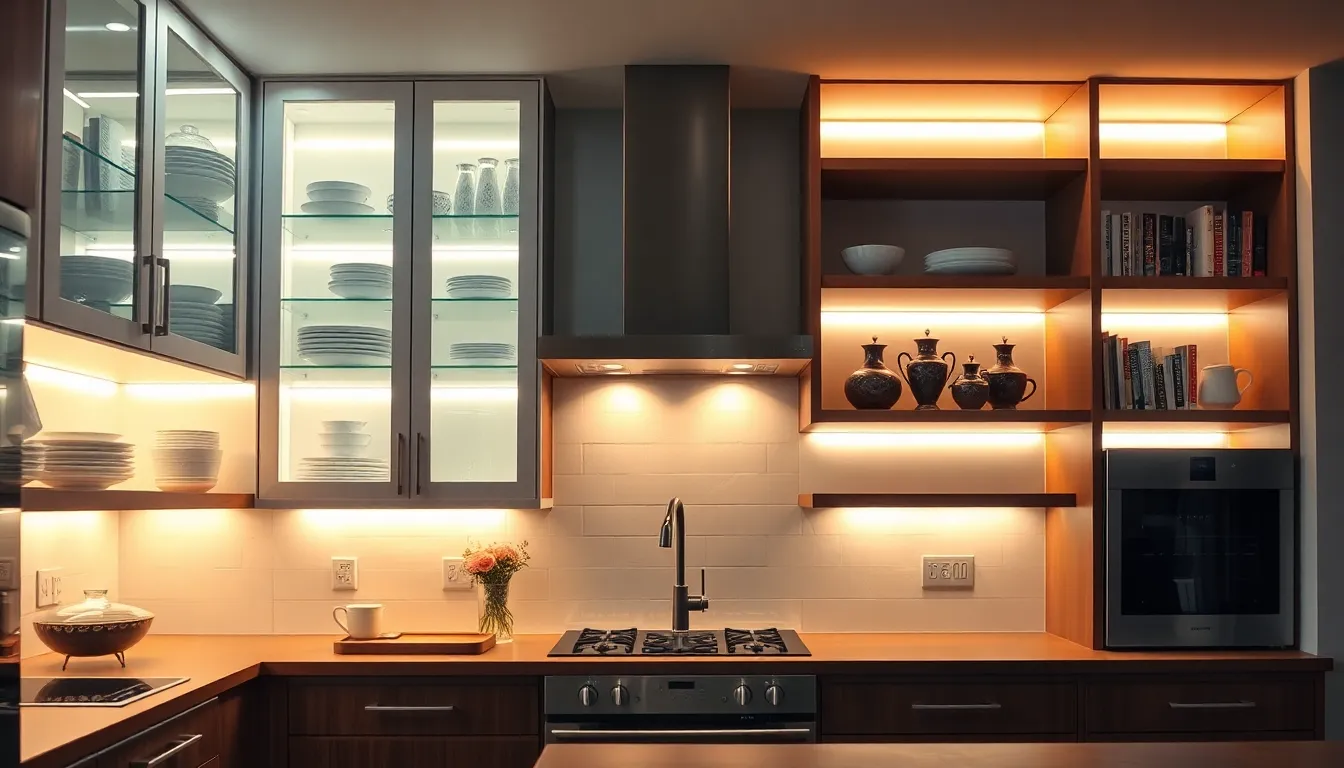
Accent lighting transforms your kitchen from purely functional to visually stunning by drawing attention to exact architectural elements and decorative features. We’ll explore strategic placement options that create depth and visual interest throughout your culinary space.
Cabinet Interior Lighting
LED strips illuminate cabinet interiors to showcase dishware collections while improving accessibility during meal preparation. We recommend installing these flexible lighting answers along the interior edges of upper cabinets where they won’t interfere with shelf placement. Motion sensor integration allows lights to activate automatically when cabinet doors open, providing instant visibility without manual switches.
Battery powered options eliminate the need for electrical work in existing cabinets, while hardwired systems offer consistent performance for new installations. Warm white temperatures between 2700K and 3000K create an inviting glow that complements most kitchen color schemes. Shelf lights mounted under individual shelves provide targeted illumination for exact items like glassware or decorative pieces.
Toe Kick Lighting for Floor Glow
LED tape lights installed beneath cabinet toe kicks create ambient floor lighting that enhances nighttime navigation safety. We position these low profile fixtures along the base of kitchen islands and perimeter cabinets to establish a continuous glow line. This technique adds visual weight to cabinetry while creating the illusion of floating elements.
Installation requires routing cables through cabinet frames or using battery powered strips for retrofit applications. Dimmer controls allow adjustment from subtle accent lighting during dinner parties to functional pathway illumination for late night activities. Cool white LEDs provide crisp definition, while warm tones create cozy atmosphere during evening hours.
Open Shelving Display Lights
Recessed lighting positioned above open shelving creates dramatic shadows that emphasize the three dimensional quality of displayed items. We angle these fixtures at 30 degree positions to minimize glare while maximizing object definition. Track mounted spotlights offer adjustable focus for highlighting exact collections or seasonal displays.
LED strips mounted below floating shelves provide upward illumination that creates visual separation between shelf levels. This technique works particularly well for glass shelving where light transmission creates layered lighting effects. Under shelf mounting eliminates fixture visibility while ensuring even light distribution across displayed objects like cookbooks, plants, or decorative ceramics.
Natural Lighting Enhancement Strategies
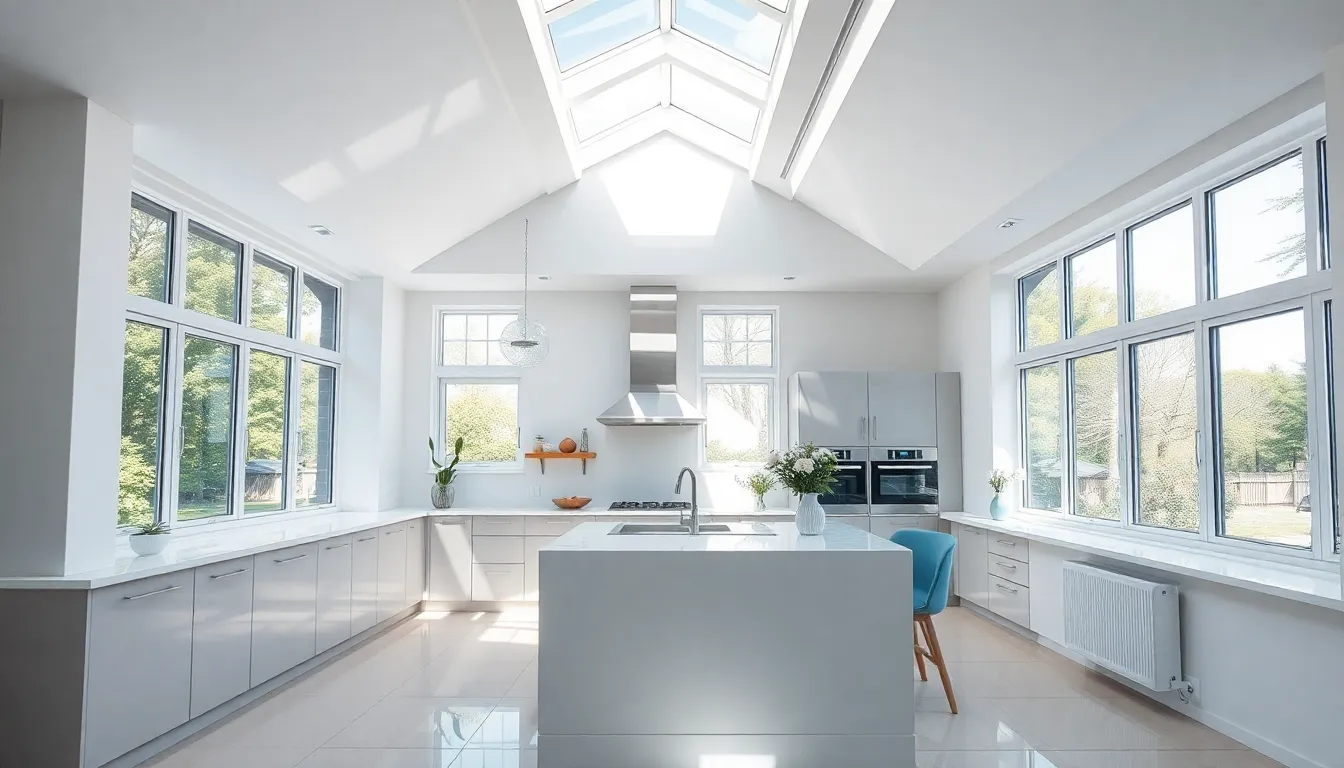
Natural light remains the most effective way to brighten your kitchen while reducing energy costs. We’ll explore three proven methods that maximize daylight and create a more inviting cooking environment.
Maximizing Window Light
Enlarging existing windows during kitchen renovations can significantly increase the amount of daylight entering your space. We recommend adding or expanding windows whenever possible, as this strategy provides the most dramatic improvement in natural illumination.
Strategic window placement makes a substantial difference in light distribution throughout the day. East facing windows capture morning sunlight while west facing options provide afternoon brightness for evening meal preparation.
Removing window treatments or replacing heavy curtains with light filtering options allows maximum light penetration. We suggest using sheer panels or adjustable blinds that provide privacy without blocking essential daylight.
Skylight Installation Benefits
Installing skylights brings additional daylight into kitchens with limited natural light throughout the year. We’ve found that skylights can increase natural light by up to 30% compared to wall mounted windows alone.
VLux Sun Tunnels offer an excellent alternative for spaces where traditional skylights aren’t feasible. These solar tubes channel daylight through reflective tunnels, delivering natural illumination to interior kitchen areas without major structural modifications.
Positioning considerations ensure optimal light distribution from overhead sources. We recommend placing skylights over central work areas like kitchen islands or main prep zones for maximum functionality.
Light-Colored Surfaces for Reflection
Using light colored surfaces for walls, countertops, and ceilings helps reflect natural light throughout the kitchen space. We’ve observed that white and cream surfaces can increase perceived brightness by up to 25% compared to darker alternatives.
Glossy finishes amplify light reflection more effectively than matte surfaces. We suggest incorporating high gloss paint, polished stone countertops, or reflective backsplash materials to maximize daylight distribution.
Strategic color placement creates the most impact when light surfaces are positioned opposite windows. We recommend painting walls perpendicular to windows in lighter shades to bounce daylight deeper into the kitchen workspace.
Modern Kitchen Lighting Fixture Trends
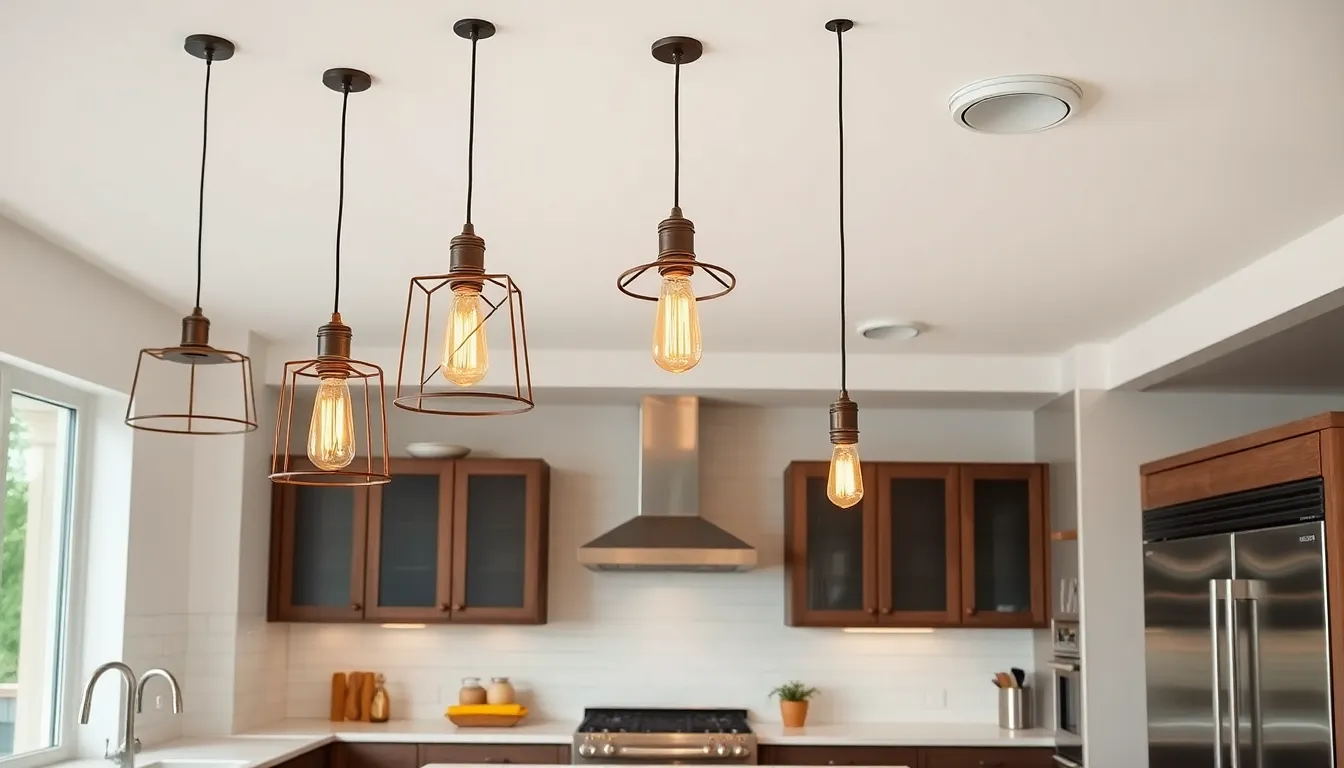
Today’s kitchen lighting trends blend cutting-edge technology with timeless design principles. We’re seeing homeowners embrace fixtures that offer both sophisticated functionality and striking visual appeal.
Smart Lighting Integration
Voice control systems transform how we interact with kitchen lighting by connecting fixtures to assistants like Alexa and Google Home. We can adjust brightness levels or turn lights on and off without touching a switch while our hands are busy cooking.
Adjustable brightness features allow smart fixtures to adapt throughout the day with customizable color temperature settings. We can create energizing bright white light for meal prep and warm amber tones for evening dining.
Energy optimization technology automatically turns lights off when rooms are empty, reducing electricity consumption by up to 40%. We’re finding that smart lighting systems learn our daily routines and adjust accordingly to maximize efficiency.
Industrial-Style Pendant Lights
Metallic accent fixtures showcase exposed metal frames that perfectly complement stainless steel appliances and hardware in modern kitchens. We love how these pendants add architectural interest while maintaining a cohesive design aesthetic.
Versatile placement options make industrial pendants ideal for kitchens, dining areas, and even commercial spaces like restaurants and cafes. We can install them over islands, peninsulas, or dining tables to create focused task lighting with dramatic visual impact.
Customizable bulb combinations let us pair industrial pendant frames with LED, Edison, or vintage-style bulbs to achieve different lighting effects. We can choose warm filament bulbs for cozy ambiance or bright LEDs for practical workspace illumination.
Minimalist Flush Mount Options
Clean line designs provide sleek, unobtrusive lighting that works beautifully in kitchens with low ceilings or open floor plans. We appreciate how flush mounts deliver essential ambient lighting without overwhelming the space.
Energy efficient performance makes these fixtures cost-effective choices, with many models featuring integrated LED technology that reduces energy consumption by 75%. We’re seeing longer lifespans of 25,000+ hours compared to traditional bulbs.
Universal style compatibility allows flush mount fixtures to enhance both contemporary and traditional kitchen designs seamlessly. We can select from brushed nickel, matte black, or white finishes to match existing hardware and create cohesive lighting schemes.
Traditional Kitchen Lighting Design Approaches
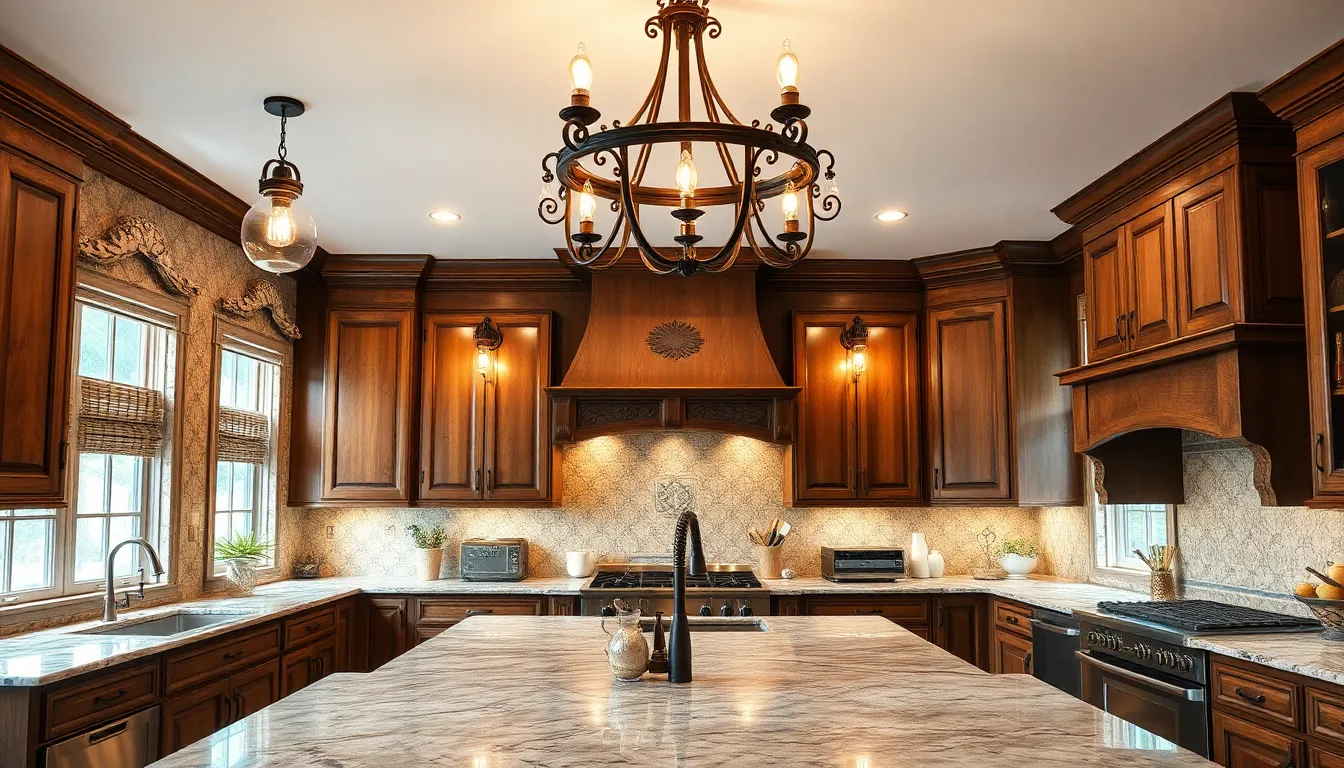
Traditional kitchen lighting design approaches combine time-tested principles with classic fixture styles to create warm and inviting spaces. We recommend layering task, ambient, and accent lighting to achieve both functionality and timeless elegance in your kitchen.
Classic Chandelier Placements
Central chandeliers transform kitchen islands and dining areas into elegant focal points while providing essential ambient lighting. We position these statement pieces 30 to 36 inches above island surfaces to ensure optimal light distribution without obstructing sightlines. Traditional chandeliers work exceptionally well in kitchens with 9-foot or higher ceilings, where they can showcase their full grandeur.
Statement chandeliers add sophistication to both traditional and modern kitchen settings by serving as architectural centerpieces. We select fixtures with multiple light sources to maximize illumination coverage across larger kitchen spaces. Crystal chandeliers reflect light beautifully off polished surfaces like granite countertops and stainless steel appliances, creating additional sparkle throughout the room.
Farmhouse-Style Pendant Lights
Rustic pendants crafted from natural materials like aged metal and reclaimed wood bring cozy charm to traditional kitchen designs. We install these fixtures in groups of two or three above kitchen islands to create visual balance while maintaining the farmhouse aesthetic. Metal pendant lights with oil-rubbed bronze or weathered finishes complement warm wood cabinetry and natural stone countertops perfectly.
Vintage-inspired pendants featuring distressed finishes and unique mason jar or wire cage shapes evoke authentic farmhouse character. We pair these fixtures with Edison bulbs to enhance their rustic appeal and create warm, inviting light that makes kitchen spaces feel more welcoming. Adjustable cord lengths allow us to customize pendant height for different ceiling configurations and personal preferences.
Vintage Edison Bulb Fixtures
Exposed bulbs in Edison style fixtures create nostalgic industrial charm that bridges traditional and contemporary kitchen designs seamlessly. We incorporate these distinctive bulbs into pendant lights, chandeliers, and wall sconces to add vintage character while providing functional illumination. Edison bulbs emit warm, amber-toned light that enhances wood tones and creates intimate atmosphere during evening hours.
Retro-chic fixtures showcase Edison bulbs as decorative elements rather than hiding them within traditional lampshades or covers. We select fixtures with clear glass globes, metal cages, or open designs that highlight the bulb’s unique filament patterns and vintage appeal. These fixtures work particularly well above breakfast nooks, coffee stations, and kitchen islands where their warm glow creates cozy gathering spaces.
Color Temperature Considerations for Kitchen Spaces
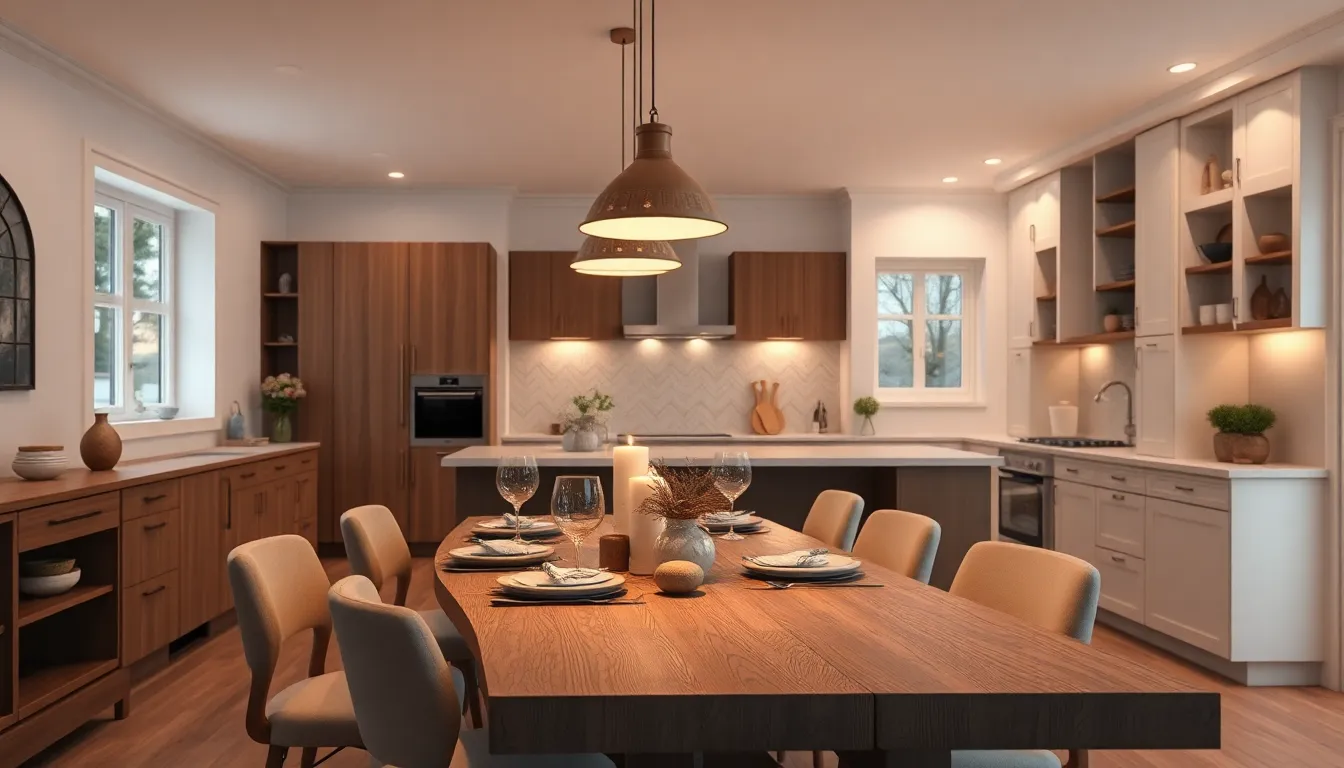
Choosing the right color temperature transforms your kitchen’s functionality and atmosphere. We’ll explore three essential temperature ranges that optimize both comfort and performance.
Warm White for Cozy Atmospheres
Warm white lighting (2700–3000K) creates inviting spaces perfect for dining and evening relaxation. These warmer hues soften harsh edges and make your kitchen feel welcoming after long days. We recommend incorporating warm white fixtures in dining nooks, breakfast bars, and seating areas where family gatherings naturally occur.
Evening ambiance benefits significantly from warm white temperature ranges. The golden tones reduce eye strain during dinner preparation and create comfortable environments for casual conversations. Wall sconces with warm white bulbs work exceptionally well near dining tables, while pendant lights over breakfast islands provide intimate lighting for morning coffee rituals.
Strategic placement of warm white fixtures balances functionality with comfort. Consider installing dimmable warm white recessed lights in areas where you transition from cooking to dining, allowing seamless mood adjustments throughout the day.
Cool White for Task-Focused Areas
Cool white lighting (3500–4100K) enhances clarity and reduces eye strain during food preparation activities. This temperature range provides optimal visibility for detailed work like chopping vegetables, reading recipes, and inspecting ingredients. We find cool white particularly effective in areas requiring precision and focus.
Countertops, islands, and sink areas benefit most from cool white illumination. Under-cabinet LED strips in cool white temperatures eliminate shadows on work surfaces, while pendant lights over kitchen islands provide clear task lighting for meal preparation. Track lighting systems with cool white bulbs offer flexible coverage for various cooking workflows.
Eye strain reduction becomes noticeable when using cool white temperatures for extended cooking sessions. The crisp illumination helps distinguish colors accurately, ensuring food safety and presentation quality. Adjustable spotlights with cool white bulbs work well above stovetops and prep areas where detailed work occurs regularly.
Daylight Balanced Options
Daylight balanced lighting (5000–6500K) mimics natural sunlight for crisp, energizing illumination. This temperature range provides the highest visual acuity, making it ideal for kitchens with limited natural light exposure. We recommend daylight balanced fixtures in pantries, utility spaces, and basement kitchens where natural light is minimal.
Areas requiring high visual acuity perform best under daylight balanced temperatures. Detailed tasks like cake decorating, food photography, and intricate cooking techniques benefit from the clear, neutral light that daylight balanced fixtures provide. LED strip lights in pantries help identify ingredients quickly and accurately.
Energizing effects of daylight balanced lighting support morning routines and productivity. The bright, clear illumination helps maintain alertness during early morning cooking sessions and meal preparation. Flush mount fixtures with daylight balanced bulbs work well in utility areas where you need maximum visibility for cleaning and organization tasks.
Layered Lighting Techniques for Complete Coverage
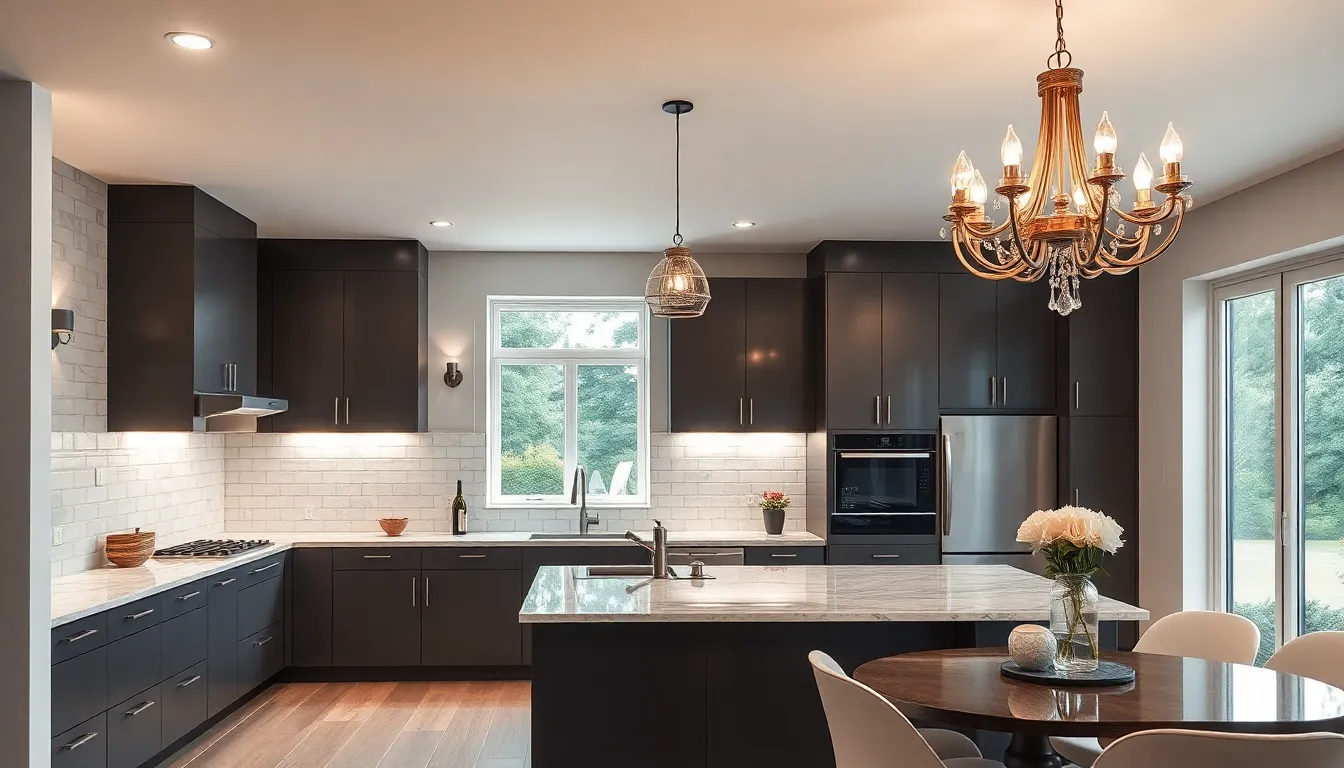
Effective kitchen lighting design relies on combining multiple light sources to create a balanced atmosphere that serves every functional and aesthetic need. We achieve this through strategic layering of task, ambient, and accent lighting elements.
Combining Multiple Light Sources
Pendant lights serve as both task and ambient lighting answers, particularly excelling over kitchen islands where they can be arranged singularly or in clusters to create unique designs. We recommend positioning them at varying heights to add visual interest while maintaining proper illumination levels.
Sconces provide versatile lighting options that deliver both ambient and task illumination with a traditional aesthetic appeal. These fixtures work exceptionally well flanking windows or architectural features, creating balanced light distribution throughout the space.
Chandeliers offer dramatic ambient lighting that transforms larger kitchens into elegant gathering spaces. We suggest selecting fixtures that complement your kitchen’s scale and style while providing sufficient brightness for daily activities.
Track lighting systems allow us to direct light precisely where needed, combining multiple adjustable fixtures on a single circuit. This flexibility makes them ideal for kitchens with changing layouts or multiple work zones.
Dimmer Switch Integration
Dimmer switches enable easy adjustment of light levels throughout the day to suit changing needs and activities. We can modify lighting intensity from bright task lighting during food preparation to softer ambient lighting during evening meals.
Flexibility becomes crucial in layered lighting design, as dimmers allow us to adjust different light sources independently based on exact activities. This control helps create the perfect atmosphere for cooking, dining, or entertaining guests.
Energy efficiency improves significantly when we incorporate dimmer switches, as reduced brightness levels consume less electricity. We can extend bulb life while maintaining optimal lighting conditions for various kitchen tasks.
Zone-Based Lighting Control
Zone-based lighting involves dividing our kitchen into different areas such as cooking, dining, and prep zones, with each area controlled independently. We can illuminate only necessary spaces, improving both efficiency and ambiance.
Smart lighting systems enable sophisticated zone control through smartphone apps or voice commands, allowing us to create custom lighting scenes for different activities. These systems can automatically adjust based on time of day or occupancy sensors.
Traditional switches connected to exact fixtures provide a more budget-friendly approach to zone control. We can install separate switches for each lighting zone, giving us precise control over which areas receive illumination at any given time.
Budget-Friendly Kitchen Lighting Solutions
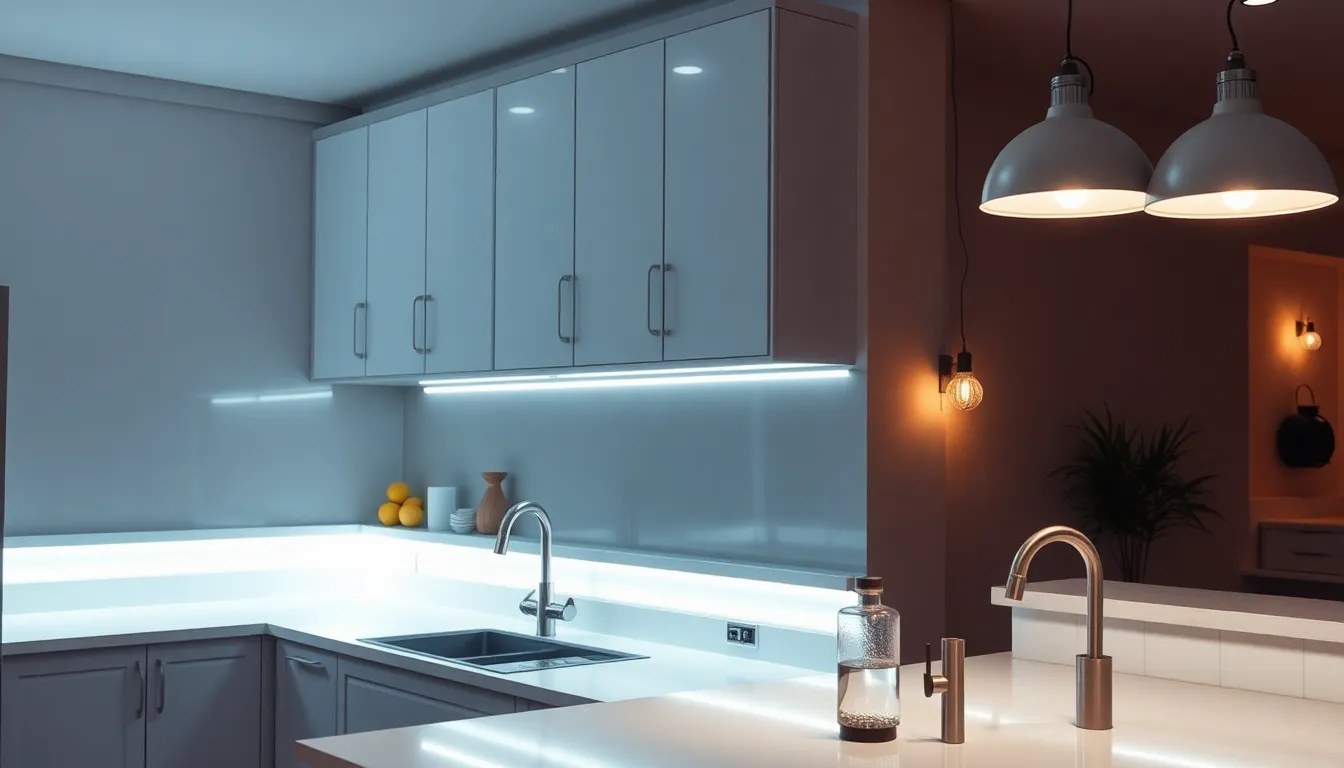
Creating well-lit kitchens doesn’t require expensive renovations or professional installations. We’ve identified practical approaches that deliver professional results while keeping costs manageable.
DIY Installation Options
LED strip lights transform kitchens instantly without requiring electrical expertise. Installing these flexible strips under cabinets or along countertops creates modern task lighting that illuminates work surfaces effectively. We recommend measuring cabinet lengths first and choosing strips with adhesive backing for simple attachment.
Plug-in fixtures eliminate costly electrical work while providing versatile lighting answers. Sconces and pendant lights with cord sets can be positioned anywhere near outlets, giving us flexibility in lighting placement. Wall-mounted sconces work particularly well for accent lighting, while plug-in pendants can highlight kitchen islands or dining areas.
Battery-powered LED lights offer wireless convenience for challenging installation areas. These fixtures work excellently inside cabinets, pantries, or areas where running electrical wire isn’t practical. Motion sensor options activate automatically, making them ideal for late-night kitchen visits.
Energy-Efficient LED Upgrades
LED bulb replacements reduce energy consumption by up to 80% compared to traditional incandescent bulbs. Simply swapping existing bulbs with LED equivalents in current fixtures provides immediate energy savings and longer bulb life. We suggest choosing bulbs with appropriate color temperatures to match your kitchen’s ambiance needs.
Smart lighting systems offer adjustable brightness and color temperature control through smartphone apps. These systems allow us to customize lighting throughout the day, from bright white for morning food prep to warm white for evening dining. Many smart bulbs connect to existing fixtures without additional wiring.
Timer and motion sensor controls maximize energy efficiency by ensuring lights operate only when needed. Installing these controls on existing fixtures prevents energy waste while providing convenient hands-free operation during cooking tasks.
Affordable Fixture Alternatives
Thrift store finds provide unique lighting options at fraction of retail costs. Vintage fixtures often need only cleaning and new bulbs to become stunning focal points. We’ve discovered that brass and copper fixtures from previous decades complement both traditional and modern kitchen designs beautifully.
Open-box deals at home improvement stores offer important discounts on quality lighting fixtures. These items typically have minor cosmetic issues or missing accessories that don’t affect functionality. Checking multiple stores regularly helps us find high-end fixtures at budget prices.
Online marketplace bargains connect us with discontinued or overstock lighting at reduced prices. Manufacturers often sell previous year models directly to consumers, providing access to quality fixtures without retail markups. Reading reviews carefully ensures we select reliable fixtures that meet our lighting needs.
Conclusion
Creating the perfect kitchen lighting design doesn’t have to be overwhelming or expensive. We’ve shown you how to transform your space using task lighting for functionality ambient lighting for atmosphere and accent lighting for visual interest.
Whether you’re planning a complete renovation or looking for simple updates we’ve provided answers for every budget and style preference. From smart LED systems to traditional chandeliers the key is layering different light sources to achieve optimal coverage.
Remember that proper color temperature selection can dramatically impact your kitchen’s mood and functionality. By combining these lighting strategies with dimmer controls and zone-based systems you’ll create a space that’s both beautiful and highly functional for years to come.
Frequently Asked Questions
What are the three essential types of kitchen lighting?
The three essential types of kitchen lighting are task lighting (for specific work areas like under-cabinet LED strips and pendant lights), ambient lighting (for overall room illumination like recessed ceiling lights and chandeliers), and accent lighting (for highlighting features like cabinet interior lighting and toe kick lighting). Combining all three creates a well-balanced, functional kitchen environment.
What color temperature is best for kitchen lighting?
For kitchens, use warm white (2700-3000K) for dining and relaxation areas, cool white (3500-4100K) for food preparation and task areas, and daylight balanced (5000-6500K) for pantries and utility spaces. Cool white is typically best for main work areas as it enhances visibility and reduces eye strain during cooking tasks.
How can I improve kitchen lighting on a budget?
Budget-friendly options include LED strip lights for under-cabinet lighting, plug-in pendant fixtures that don’t require electrical work, battery-powered LED puck lights for cabinets, and replacing existing bulbs with energy-efficient LEDs. You can also find affordable fixtures at thrift stores, online marketplaces, and open-box deals from retailers.
Where should pendant lights be placed over a kitchen island?
Pendant lights should be positioned 30-36 inches above the kitchen island surface for optimal light distribution. For longer islands, use multiple pendants spaced evenly, typically 24-30 inches apart. The size should be proportional to the island – larger islands can accommodate bigger or multiple fixtures for proper illumination coverage.
How do I maximize natural light in my kitchen?
Maximize natural light by enlarging existing windows or adding new ones, installing skylights (which can increase natural light by up to 30%), and using light-colored surfaces on walls, countertops, and ceilings. Light-filtering window treatments and glossy finishes help reflect and distribute natural light throughout the space more effectively.
What are the benefits of LED lighting in kitchens?
LED lights offer significant energy savings, longer lifespan (up to 25,000 hours), and produce less heat than traditional bulbs. They’re available in various color temperatures, can be dimmed for mood lighting, and are ideal for under-cabinet installations. LEDs also reduce electricity costs and require less frequent replacement, making them cost-effective long-term.
How do I create layered lighting in my kitchen?
Create layered lighting by combining task lighting (under-cabinet LEDs, pendant lights), ambient lighting (recessed ceiling lights, chandeliers), and accent lighting (cabinet interior lights, toe kick lighting). Install dimmer switches to adjust brightness levels throughout the day, and consider zone-based controls to independently illuminate different kitchen areas as needed.
Are smart lighting systems worth it for kitchens?
Smart lighting systems offer convenient voice control, customizable brightness and color temperature settings, energy monitoring, and scheduling capabilities. They’re particularly valuable in kitchens for hands-free operation while cooking, automatic adjustment to daily routines, and enhanced energy efficiency. However, they require higher initial investment compared to traditional lighting solutions.
